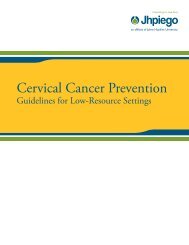Manual for Male Circumcision under Local Anaesthesia
Manual for Male Circumcision under Local Anaesthesia
Manual for Male Circumcision under Local Anaesthesia
You also want an ePaper? Increase the reach of your titles
YUMPU automatically turns print PDFs into web optimized ePapers that Google loves.
<strong>Male</strong> circumcision <strong>under</strong> local anaesthesia<br />
Version 3.1 (Dec09)<br />
The quality of male circumcision services can be defined through the<br />
development and communication of standards. Quality can then be<br />
measured by determining whether the standards are being met.<br />
Various methods can be used to measure quality, e.g. selfassessment,<br />
peer assessment and external assessment. Quality<br />
improvement methodology can be used to continuously improve the<br />
quality of male circumcision care and services.<br />
WHO has developed a comprehensive guide to quality assurance 1 <strong>for</strong><br />
male circumcision programmes. The guide defines ten service<br />
standards that each programme should meet (Box) and includes the<br />
essential competences <strong>for</strong> male circumcision service provision. In<br />
addition it outlines the process of quality assessment and includes<br />
guidance <strong>for</strong> facility managers and staff. The guide is supplemented<br />
by a toolkit 2 to assist managers and staff assess the quality of<br />
services.<br />
Recommended male circumcision service standards<br />
1. An effective management system is established to oversee the<br />
provision of male circumcision services.<br />
2. A minimum package of male circumcision services is provided.<br />
3. The facility has the necessary medicines, supplies, equipment<br />
and environment <strong>for</strong> providing safe male circumcision services of<br />
good quality.<br />
4. Providers are qualified and competent.<br />
5. Clients are provided with in<strong>for</strong>mation and education on HIV<br />
prevention and male circumcision.<br />
6. Assessments are per<strong>for</strong>med to determine the condition of clients.<br />
7. <strong>Male</strong> circumcision surgical care is delivered according to<br />
evidence-based guidelines.<br />
8. Infection prevention and control measures are practised.<br />
9. Continuity of care is provided.<br />
10. A system <strong>for</strong> monitoring and evaluation is established.<br />
SUPERVISION<br />
Traditional approaches to supervision emphasize inspecting facilities<br />
and checking individual per<strong>for</strong>mance. They focus on finding fault or<br />
errors, and sanctioning those responsible, or thought to be<br />
responsible. This type of supervision often causes negative feelings<br />
and rarely results in an improved service.<br />
In contrast, supervision <strong>for</strong> per<strong>for</strong>mance and quality improvement<br />
focuses on:<br />
1<br />
2<br />
World Health Organization. <strong>Male</strong> circumcision quality assurance: a guide to enhancing the safety and<br />
quality of services. Geneva, World Health Organization, 2008 (available at www.malecircumcision.org)<br />
World Health Organization. <strong>Male</strong> circumcision services quality assessment toolkit. Geneva, World<br />
Health Organization, 2009 (available at www.malecircumcision.org)<br />
Record keeping, monitoring, evaluation and supervision Chapter 9-5
















